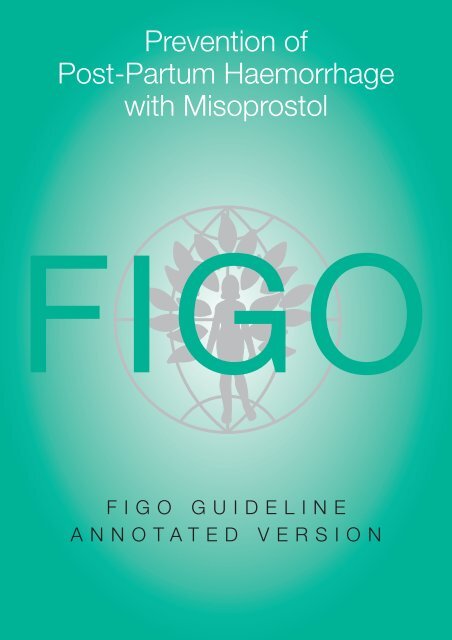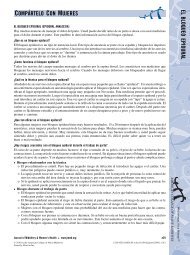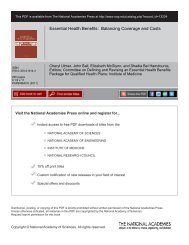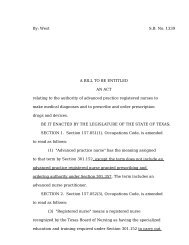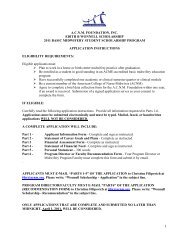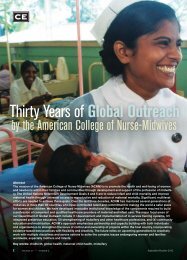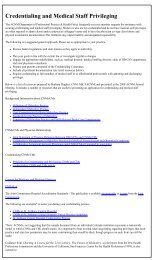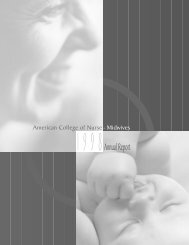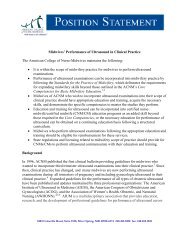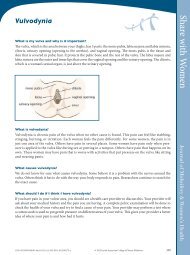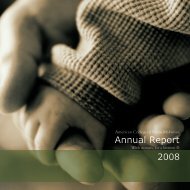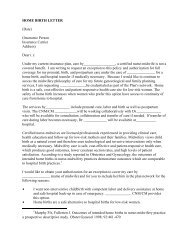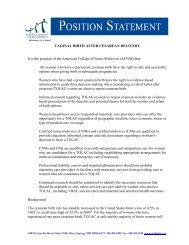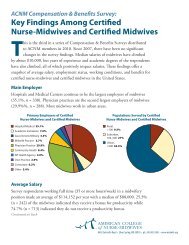Prevention of Post-Partum Haemorrhage with Misoprostol
Prevention of Post-Partum Haemorrhage with Misoprostol
Prevention of Post-Partum Haemorrhage with Misoprostol
You also want an ePaper? Increase the reach of your titles
YUMPU automatically turns print PDFs into web optimized ePapers that Google loves.
<strong>Prevention</strong> <strong>of</strong><br />
<strong>Post</strong>-<strong>Partum</strong> <strong>Haemorrhage</strong><br />
<strong>with</strong> <strong>Misoprostol</strong><br />
FIGO<br />
FIGO GUIDELINE<br />
ANNOTATED VERSION
<strong>Prevention</strong> <strong>of</strong><br />
<strong>Post</strong>-<strong>Partum</strong> <strong>Haemorrhage</strong><br />
<strong>with</strong> <strong>Misoprostol</strong><br />
Background Evidence<br />
<strong>Post</strong>-partum haemorrhage (PPH) is the<br />
most important direct cause <strong>of</strong> maternal<br />
mortality in low resource countries, and one<br />
<strong>of</strong> the most preventable. As the most common<br />
cause for PPH is the failure <strong>of</strong> the<br />
uterus to contract adequately (atonic<br />
uterus), a key aspect in prevention <strong>of</strong><br />
PPH is uterotonic therapy. The most widely<br />
used agent is injectable oxytocin. However,<br />
it requires parenteral administration,<br />
and, therefore, skills to give injections as<br />
well as sterile equipment; and refrigeration.<br />
For this reason, misoprostol, an E1<br />
prostaglandin analogue, has attracted<br />
considerable attention as an alternative to<br />
oxytocin for the prevention <strong>of</strong> PPH in resource<br />
poor settings. <strong>Misoprostol</strong> is effective,<br />
simple to administer, and presents<br />
none <strong>of</strong> the logistical difficulties associated<br />
<strong>with</strong> use <strong>of</strong> oxytocin.<br />
In 2011, the World Health Organization<br />
added misoprostol (600 µg orally) to its<br />
Model List <strong>of</strong> Essential Medicines for the<br />
prevention <strong>of</strong> PPH [WHO prevention guidelines,<br />
WHO EML 2011].<br />
<strong>Misoprostol</strong> versus conventional injectable<br />
uterotonics in the prevention <strong>of</strong><br />
PPH<br />
A systematic review <strong>of</strong> 16 randomised con-<br />
FIGO GUIDELINE<br />
trolled trials (RCTs) <strong>of</strong> misoprostol versus<br />
injectable uterotonics, involving in total<br />
29,042 women, has shown that oral misoprostol<br />
is less effective than injectable<br />
uterotonics in preventing severe PPH<br />
(blood loss >1000 mL: 3.3% v. 2.4%, relative<br />
risk (RR) 1.32; 95% confidence interval<br />
(CI) 1.16 to 1.51) [Gülmezoglu 2007].<br />
There is less data on the use <strong>of</strong> ergometrine<br />
for the prevention <strong>of</strong> PPH. In one<br />
double blind RCT involving 1,229 home<br />
births attended by traditional birth attendants<br />
(TBAs) in rural Gambia, 600 µg oral<br />
misoprostol was compared <strong>with</strong> 2 mg oral<br />
ergometrine. While there were no significant<br />
differences in measured post-partum blood<br />
loss ≥ 500 mL or post-partum Hb < 8 g/dL,<br />
misoprostol was more effective at reducing<br />
pre- to post-partum Hb ≥ 3 g/dL<br />
(16.4% vs. 21.2%; RR=0.77, 95% CI<br />
0.60-0.98). Shivering was significantly<br />
more common <strong>with</strong> misoprostol, but vomiting<br />
more common <strong>with</strong> ergometrine [Walraven<br />
2005].<br />
A review <strong>of</strong> six studies that used a combination<br />
<strong>of</strong> oxytocin 5 IU and ergometrine<br />
500 µg (Syntometrine ® ) injected intramuscularly<br />
indicates that it is slightly more<br />
effective than IM oxytocin alone in reducing<br />
PPH > 500 mL (odds ratio (OR) 0.82,
P r e v e n t i o n o f P o s t - P a r t u m H a e m o r r h a g e w i t h M i s o p r o s t o l<br />
95% CI 0.71 to 0.95), but <strong>with</strong> higher rates<br />
<strong>of</strong> hypertension and vomiting [McDonald<br />
2004]. Furthermore, the one study that tested<br />
IV ergometrine as part <strong>of</strong> an active management<br />
package <strong>with</strong> physiological management<br />
found improvements in PPH<br />
rates but a large increase in the rate <strong>of</strong> retained<br />
placenta [Begley 1990]. It is on this<br />
basis that FIGO and WHO recommend the<br />
use <strong>of</strong> IM oxytocin 10 IU in preference to<br />
the ergometrine containing products.<br />
<strong>Misoprostol</strong> in the prevention <strong>of</strong> PPH in<br />
situations <strong>with</strong>out access to oxytocin<br />
Early placebo-controlled trials <strong>of</strong> misoprostol<br />
conducted in hospital settings had<br />
variable results, and meta-analysis showed<br />
variable effects on PPH rates [Gülmezoglu<br />
2007]. They did, however, consistently<br />
show that misoprostol markedly reduced<br />
the need for postnatal blood transfusion<br />
(RR 0.31; 95% CI 0.10 to 0.94). In<br />
addition, the three large scale placebocontrolled<br />
studies published since 2005<br />
have all consistently shown positive effects<br />
<strong>of</strong> misoprostol in reducing post-partum<br />
blood loss [Høj 2005, Derman 2006,<br />
Mobeen 2011]. All three trials used misoprostol<br />
600 µg, orally or sublingually, in<br />
community or primary health care settings<br />
<strong>with</strong>out access to conventional injectable<br />
uterotonics. The first was a randomised trial<br />
<strong>of</strong> 661 women attended by midwives in<br />
a primary health centre in Guinea-Bissau.<br />
Findings indicated sublingual misoprostol<br />
600 µg was significantly better than place-<br />
bo at reducing severe PPH (blood loss ≥<br />
1000 mls) [Hoj 2005]. The second, involving<br />
1,620 home births attended by auxiliary<br />
nurse midwives in rural India showed<br />
600 µg oral misoprostol to be significantly<br />
better than placebo at reducing most indicators<br />
<strong>of</strong> PPH: blood loss ≥ 500 mL, ≥<br />
1000 mL, need for transfer to a health facility,<br />
blood transfusion, and surgical interventions<br />
[Derman 2006]. The third, involving<br />
1,119 home births attended by<br />
trained TBAs in Pakistan, showed that<br />
compared <strong>with</strong> placebo, 600 µg oral misoprostol<br />
significantly reduced the rate <strong>of</strong> PPH<br />
(≥ 500 mL) (16.5% versus 21.9%, RR 0.76,<br />
95% CI 0.59-0.97) and incidence <strong>of</strong> postpartum<br />
declines in haemoglobin > 3 g/dl<br />
[Mobeen 2011].<br />
Doses <strong>of</strong> under 600 µg have also been<br />
studied in an attempt to reduce the incidence<br />
<strong>of</strong> shivering and fever. However, results<br />
across trials have been inconsistent.<br />
While there is some data to suggest that<br />
a lower dose <strong>of</strong> misoprostol may also be<br />
effective and could reduce the incidence<br />
<strong>of</strong> side effects, there is a greater body <strong>of</strong><br />
evidence in support <strong>of</strong> a 600 µg regimen,<br />
and prolonged or serious side effects are<br />
uncommon.
P r e v e n t i o n o f P o s t - P a r t u m H a e m o r r h a g e w i t h M i s o p r o s t o l<br />
Regimen<br />
A single dose <strong>of</strong> misoprostol 600 µg orally<br />
is indicated for prevention <strong>of</strong> PPH in settings<br />
where oxytocin is not available. The<br />
recommended dose does not change according<br />
to the woman’s weight.<br />
Course <strong>of</strong> Treatment<br />
<strong>Misoprostol</strong> should be administered immediately<br />
after delivery <strong>of</strong> the newborn. It<br />
is good practice to first do an abdominal<br />
palpation to confirm that there are no additional<br />
babies in utero.<br />
Contraindications<br />
History <strong>of</strong> allergy to misoprostol or other<br />
prostaglandin.<br />
Side Effects<br />
Temperature changes: Shivering, chills<br />
and/or fever are all commonly associated<br />
<strong>with</strong> misoprostol. Shivering is the most<br />
common side effect and is occasionally accompanied<br />
by fever. In the large WHO multicentre<br />
study using 600 µg oral misoprostol,<br />
shivering was experienced by<br />
18% <strong>of</strong> women, but temperatures <strong>of</strong> over<br />
38°C or 40°C were found in only 6 and<br />
0.1%, respectively [Gülmezoglu 2001].<br />
Similarly, when Derman et al. used 600 µg<br />
in rural India, shivering occurred in 52.2%<br />
<strong>of</strong> women, but fever in only 4.2% [Derman<br />
2006]. The shivering is self-regulating and<br />
even if high temperatures occur, they are<br />
transient and settle <strong>with</strong> reassurance and<br />
symptomatic treatment.<br />
Gastro-intestinal effects: Transient diarrhoea,<br />
nausea and vomiting may occur following<br />
misoprostol, but are rare, occurring<br />
in less than 1% women [Gülmezoglu<br />
2001]. An anti-emetic can be used if<br />
needed, but in general no action is required<br />
except to reassure the woman and her<br />
family.<br />
Breast feeding: Small amounts <strong>of</strong> misoprostol<br />
or its active metabolite may appear<br />
in breast milk. No adverse effects on<br />
nursing infants have been reported.<br />
Self-Administration<br />
In community settings where oxytocin is not<br />
available, there are ongoing programmes<br />
in which women are given misoprostol<br />
tablets for self-administration after delivery.<br />
Reports from these programmes suggest<br />
that this can be done safely and effectively,<br />
but further research is in progress that<br />
will clarify the matter. Those providing<br />
misoprostol in this way are advised to monitor<br />
its use, effectiveness and side-effects;<br />
and to make an effort to ensure that, in cases<br />
<strong>of</strong> multiple pregnancies, misoprostol is<br />
not administered until after all babies have<br />
been delivered.
P r e v e n t i o n o f P o s t - P a r t u m H a e m o r r h a g e w i t h M i s o p r o s t o l<br />
References<br />
Begley CM. A comparison <strong>of</strong> ‘active’ and<br />
‘physiological’ management <strong>of</strong> the third<br />
stage <strong>of</strong> labour. Midwifery 1990;6:3-17.<br />
Derman RJ, Kodkany BS, Goudar SS et al.<br />
Oral misoprostol in preventing postpartum<br />
haemorrhage in resource-poor communities:<br />
a randomized controlled trial. Lancet<br />
2006;368:1248-53.<br />
Durocher J, Bynum J, León W, Barrera G,<br />
Winik<strong>of</strong>f B. High fever following postpartum<br />
administration <strong>of</strong> sublingual misoprostol.<br />
BJOG. 2010 Jun;117(7):845-52.<br />
Elati A, Elmahaishi MS, Elmahaishi MO, Elsraiti<br />
OA, Weeks AD. The effect <strong>of</strong> misoprostol<br />
on postpartum contractions: a<br />
randomised comparison <strong>of</strong> three sublingual<br />
doses. BJOG. 2011 Mar;118(4):466-73.<br />
Gülmezoglu AM, Villar J, Ngoc NT, Piaggio<br />
G, Carroli G, Adetoro L, et al. WHO multicentre<br />
randomised trial <strong>of</strong> misoprostol in<br />
the management <strong>of</strong> the third stage <strong>of</strong><br />
labour. Lancet 2001 Sep 1;358(9283):689-<br />
95.<br />
Gülmezoglu AM, Forna F, Villar J, H<strong>of</strong>meyr<br />
GJ. Prostaglandins for preventing postpartum<br />
haemorrhage. Cochrane Database<br />
<strong>of</strong> Systematic Reviews 2007, Issue<br />
3. Art. No.: CD000494. DOI:<br />
10.1002/14651858.CD000494.pub3.<br />
H<strong>of</strong>meyr GJ, Gülmezoglu AM, Novikova N,<br />
Linder V, Ferreira S, Piaggio G. <strong>Misoprostol</strong><br />
to prevent and treat postpartum haem-<br />
orrhage: a systematic review and metaanalysis<br />
<strong>of</strong> maternal deaths and dose-related<br />
effects. Bull World Health Organ.<br />
2009 Sep;87(9):666-77.<br />
Høj L, Cardosa P, Nielsen BB, Hvidman L,<br />
Nielsen J, Aaby P. Effect <strong>of</strong> sublingual misoprostol<br />
on severe postpartum haemorrhage<br />
in a primary health centre in Guinea-Bissau:<br />
randomised double blind clinical trial. BMJ<br />
2005;331:723.<br />
McDonald SJ, Abbott JM, Higgins SP. Prophylactic<br />
ergometrine-oxytocin versus oxytocin<br />
for the third stage <strong>of</strong> labour. Cochrane<br />
Database <strong>of</strong> Systematic Reviews 2004, Issue<br />
1. Art. No.: CD000201. DOI:<br />
10.1002/14651858.CD000201.pub2.<br />
Mobeen N, Durocher J, Zuberi N, Jahan N,<br />
Blum J, Wasim S, Walraven G, Hatcher J.<br />
Administration <strong>of</strong> misoprostol by trained traditional<br />
birth attendants to prevent postpartum<br />
haemorrhage in homebirths in<br />
Pakistan: a randomised placebo-controlled<br />
trial. BJOG. 2011;118(3):353-61.<br />
Walraven G, Blum J, Dampha Y, Sowe M,<br />
Morison L, Winik<strong>of</strong>f B, Sloan N. <strong>Misoprostol</strong><br />
in the management <strong>of</strong> the third stage <strong>of</strong><br />
labour in the home delivery setting in rural<br />
Gambia: a randomised controlled trial.<br />
BJOG 2005;112(9):1277-83.<br />
World Health Organization. Guidelines for<br />
the prevention <strong>of</strong> postpartum haemorrhage.<br />
World Health Organization, Geneva,<br />
2007.<br />
World Health Organization. Model List <strong>of</strong>
P r e v e n t i o n o f P o s t - P a r t u m H a e m o r r h a g e w i t h M i s o p r o s t o l<br />
Essential Medicines 2011, 17th Edition.<br />
World Health Organization, Geneva, 2011.<br />
Abbreviations<br />
CI confidence interval<br />
FIGO International Federation <strong>of</strong><br />
Gynecology and Obstetrics<br />
Hb haemoglobin<br />
G/dl gramme per decilitre<br />
IM intramuscular<br />
IU international unit<br />
IV intravenous<br />
µg microgramme<br />
Mg milligramme<br />
ML millilitre<br />
OR odds ratio<br />
PPH post-partum haemorrhage<br />
RCT randomised controlled trial<br />
RR relative risk<br />
TBA traditional birth attendant<br />
WHO World Health Organization<br />
International Federation <strong>of</strong><br />
Gynecology and Obstetrics<br />
FIGO Secretariat, FIGO House,<br />
Waterloo Court, Suite 3, 10 Theed Street,<br />
London SE1 8ST, United Kingdom<br />
Tel: + 44 20 7928 1166 | Fax: + 44 20 7928 7099<br />
Email: figo@figo.org | www.figo.org<br />
ANNOTATED VERSION | May 2012


